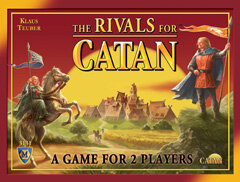Game Review: ‘The Rivals For Catan’

Every year, the happy task at the big annual game conventions is the same: find the one or two exceptional, standout gems among the many new releases. There is really no way to tell in advance what this game, supplement, or other product is going to be and sometime it is not even clear until one gets home and has a chance to actually try out their new acquisitions.
This year, I found that gem at Gen Con Indy, and it was unequivocally Mayfair Games’ “The Rivals for Catan,” a new and completely revised version of a German game released by game guru Klaus Teuber in 1996. There is, frankly, nothing about the inauspicious little box this game comes in to suggest just how terrific it is and I was thus both a little surprised and very pleased when I tried it out for the first time two months ago. It would be fair to say, in fact, that this review is overdue in part because I have put so much of the time I devote to scrutinizing and writing about games into playing this one.
In this two-person card game, each player controls a fledgling principality and must build new settlements, upgrade them to cities, and then add urban infrastructure like universities, taverns, merchant guilds, and the like. The rivals accomplish these things by collecting, storing, trading, and spending various resources (brick, grain, lumber, wool, ore, and gold) from the regions associated with their settlements (i.e., hills, fields, forests, pastures, mountains, and gold fields, respectively). These activities are supported through constructing things like workshops that enhance the production of resources (e.g., Brick Factory, Grain Mill), launching trade ships, summoning heroes, and playing various event cards. While the importance of military strength is implied, this is not a wargame and the emphasis is on development and trade. The winner is the player to first achieve a specified number of victory points (e.g., 10-13).
Suffice it to say, the rules for “The Rivals for the Catan” are exceptionally elegant and clean and, in the dozens of games we have played, my wife and I have not identified a single hole or flaw in them (although there were a few cards that it took us a number of games to fully appreciate or figure out how to use correctly).
Learning “The Rivals for the Catan” is, in any event, made easy through first an introductory game and then three thematic games, each of which introduces players to a different set of cards, “The Era of Gold,” “The Era of Turmoil,” and the “Era of Progress.” All of these rules and themes then culminate in “The Duel of the Princes,” which combines them into a single game. Many different sorts of strategies are possible in this combined game depending on which types of cards players are most comfortable with (e.g., I like trying to develop gold fields, using Era of Gold cards, and building a mercantile principality, while my wife generally tries to build a university and pursue and Era of Progress strategy).
Components include 180 cards, two dice (production and event), a trade token, a hero token, and a rulebook/card index. These components are premium, and include thick, laminated, round-edged cards that are square — making it easy to shuffle them and quickly and easily reset or put away the game — and wooden dice and tokens.
In theme and tone “The Rivals for the Catan” is very similar to “Settlers of Catan,” the board game that is its inspiration; art by Michael Menzel is evocative of a late medieval/early Renaissance northern European culture and the overall feeling is suggestive of a hardworking Saxon culture and Protestant work ethic (it is, after all, at root a German game!).
Mechanically, of course, being a card rather than a board game, “Rivals” differs from its predecessor in many ways and calls for a different approach and strategies. For example, when the Brigand attacks in “Settlers,” everyone with eight or more resources loses half of them but, in “Rivals,” when the event die indicates a Brigand Attack anyone with eight or more resources loses any sheep or gold they have (unless, of course, it safeguarded by a storehouse or gold cache).
“The Rivals for the Catan” is suitable for adults and smart, game-oriented pre-teens and retails for $20. Play time is about an hour for the introductory and thematic starter games and probably around an hour-and-a-half for the combined Duel of the Princes. Overall, it is a great game and a good value. And, with so many of the best new games being suitable or optimum only for three or more players, it is nice to have a fun game that my wife and I can play without needing to recruit someone else!